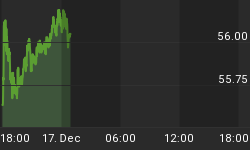They always tell you no one rings a bell when a market top or bottom is reached. But a bell is now ringing for the end of the thirty-year bull market in U.S. debt. And ironically, the bell ringer is our very own U.S. Treasury!
The U.S. Treasury Borrowing Advisory Committee, which brings together dealers and Treasury officials, met last week in a closed meeting at the Hays Adams Hotel. The committee members unanimously agreed that the Treasury should start permitting negative interest rate bids for T-bills. In other words, newly issued T-bills from the Treasury would offer investors a guaranteed negative return if held to maturity. The mania behind the U.S. debt market has reached such incredible proportions that investors are now willing to lend money to the government at a loss; right from the start of their investment. This is a clear signal that the bond market can't get any more overcrowded and can't get any more overpriced.
Of course, many in the MSM contend there is justification for today's ridiculously low bond yields and that a bubble in U.S. debt is impossible. But those are some of the same individuals who claimed back in 2006 that home prices could never decline on a national level and any talk of a bubble in real estate was nonsense. These are also the same people who assured investors in the year 2000 that prices of internet stocks were fairly priced because they should be valued based upon the number of eyeballs that viewed a webpage.
But we can easily see the future of U.S. Treasuries from viewing what is occurring in Portugal and Greece today. Portugal and Greece were able to borrow tremendous amounts of money because they converted their domestic currencies to the Euro and therefore, had the German balance sheet behind them. If these two countries had to borrow in Escudo's and Drachma's instead, yields would have increased much earlier, forcing a reconciliation of the debt years before a major crisis occurred. Therefore, their current debt to GDP ratios would be much more manageable. But now their bond bubbles have burst. The yield on the Portuguese 10 year was 5% a year and a half ago; today it is 15%. Greek 10 year bonds yielded 5% two and a half years ago; today they are 34%! The bottom line is that these counties were able to borrow more money than their economy was able to sustain because their interest rates were kept artificially low.
Likewise, the U.S. was and still is able to borrow a tremendous amount of money--far more that can be sustained by its income and revenue--because interest rates have been artificially low for far too long. Not only has the Fed pegged interest rates at zero percent since December 2008, but the U.S. dollar has been the world's reserve currency for decades. These two factors combined have deceived the U.S. into believing it can add about 8% of GDP to its debt each year. And since the end of 2007, the amount of publicly traded debt has increased by nearly $6 trillion; that's over 100 percent!
New Treasury issuance will be inexorably north of $1 trillion for at least the next decade to come. Along with that increasing debt supply, there is tremendous inflationary pressure coming from the expansion of the Fed's balance sheet and a Fed Funds rate that will end up being at zero percent for at least six years in total. Those two factors alone paint a very ugly picture for the direction of bond prices.
Manias can last a very long time and become more extended than reason should allow. But wise investors should prepare now for the upcoming interest rate shock and continue to accumulate anti-dollar investments. Once the bond bubble explodes here as it did in Southern Europe it will destroy the dollar along with it. That's because the sellers of U.S. debt will be forced to abandon dollar based holdings completely. That will mark the end of the U.S. dollar as the world's reserve currency and the restoration of gold as the global store of wealth.















